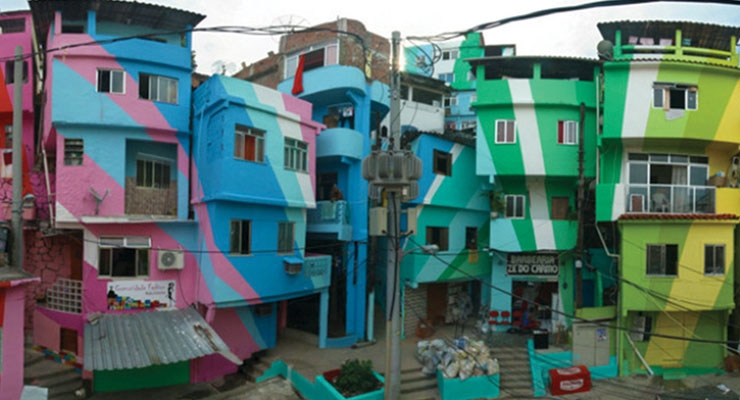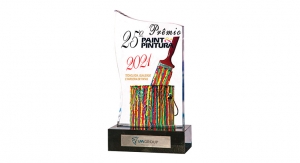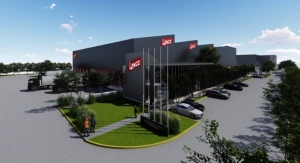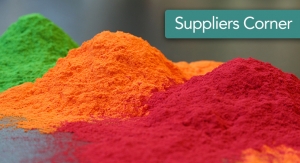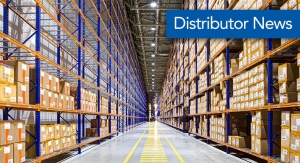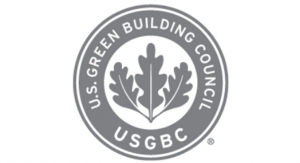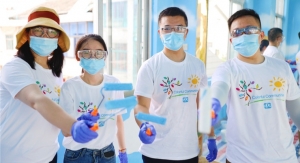Charles W. Thurston, Latin America Correspondent06.17.15
The estimated $10 billion demand in Latin America for paints and coatings is oddly mixed this year, as the economies in some of the largest countries – including Brazil and Colombia – slow down, while others like Mexico, Peru and the Caribbean accelerate modestly. Overall, a regional expansion of 0.9 percent is estimated by the International Monetary Fund (IMF) this year, while the forecast for 2016 is 2.0 percent. This makes for difficult investment plans and more costly importation of raw and finished materials, although some paint markets in some countries are still growing at a few percentage points above gross domestic product (GDP), a tendency during growth years.
One recent effort to smooth out paint industry policy, data collection, and stimulation measures was the formation of the region-wide paint and coatings association in Latin America, the Federación Latinoamericana de Fabricantes de Pinturas (LatinPat), or the Latin American federation of paint manufacturers, with a headquarters in Mexico, and officers in Brazil and Argentina. Latinpat is headed by Javier Maldonado Moctezuma, the general director of PSI Pinturas, based in the city and state of Puebla.
Countries with Accelerating Growth
IMF suggests that the strongest growth – at 0.2 percent or greater – is occurring this year in Mexico, Peru, Chile, Honduras, Costa Rica and the Caribbean.
Mexico is perhaps the most promising market for paint and coatings in the region, as a result of both its growth rate and its size. With a 3.1 percent growth rate this year, and a forecast 3.3 percent in 2016, the IMF reckons, Mexico’s GDP has a value of $1.26 trillion, a sizeable component of the entire region, at about $6 trillion. The PPG acquisition of Comex is expected to lead to a broader offering of paints and coatings in Mexico, and in the Central American/Caribbean region Comex now services.
PPG is investing more than $27 million in its San Juan del Rio, Queretaro, Mexico, coatings manufacturing facility. “The additional capacity will enable PPG to meet increasing demand for its coatings by automotive OEM, protective and marine, packaging and industrial customers in Mexico,” said Mark Silvey, a PPG spokesman.
In the Caribbean, growth is being led by the Dominican Republic, at 5.1 percent this year, with an accompanying GDP value of about $6 billion. With a strong history of export assembly, demand for paints and coatings is likely to be centered on powder coatings for consumer goods parts.
In Central America, Panama is exhibiting the strongest growth at 6.1 percent, according to the IMF forecast. Panama has become a major real estate market for foreign investors, helping drive the demand for architectural paints. American Paint Company is one leading domestic paint manufacturer there.
In a regional move, Andes Chemical in August forged an alliance with Croda International, based in East Yorkshire, UK, to provide water-based paint and coatings chemicals to paint manufacturers in the Caribbean and to Central America. Croda has a laboratory in Mexico, and had plans last year to build a laboratory in Campinas, Brazil.
Countries With Stable Growth
The IMF defines stable growth as running between plus-or-minus 0.2 percent, or flat growth, in the 2015 vs. 2014 comparison. The countries with this rate Guatemala, Nicaragua, and Guyana, which together represent only about $70 million of total GDP value.
Paint and coatings distributed in these countries is often managed through Panama, which is the de facto warehousing center of both the Caribbean and Central America.
Countries with Moderate Slowdown
The IMF defines a moderate slowdown in growth as falling between -0.2 and -1.0 percent. The countries in this category include Argentina, Uruguay, Paraguay and Suriname.
Argentina is the most important of these markets, with a $636 billion economy. This year, the GDP there is shrinking by 0.3 percent, and the forecast is for 0.1 percent positive growth next year. With a relatively strong automotive industry, Argentina has attracted substantial domestic production investment. However, the economic uncertainties that seem to cover the country like a permanent smog, tend to limit both industrial and architectural segment consumptions.
Countries with Marked Slowdown of -1.0 or More
Much of the Latin American region’s GDP is in this category of contracting economies this year, with Brazil, Colombia, Venezuela, Bolivia and Ecuador included, the IMF suggests.
Brazil is the largest market in the region, and is struggling to reverse its current fortune. Dilson Ferreira, the executive director of the Associacao das Fabricantes de Tintas (Abrafati), the national paint manufacturers association, said in February that, “Adjustments always cause pain, and this (year) will be no exception. However, once we have this period behind us, we will be in a better position to advance.” He noted that one bright point for the architectural segment this year is the government’s housing construction program, “Minha Casa, Minha Vida” (My Home, My Life), which will help make up for slower consumer purchases.
In its 2014 annual report BASF noted that “ Following the sharp declines of the previous year, we predict widespread stagnation in the consumer goods industry in Brazil.” BASF’s Suvinil brand is the architectural market leader in the country. “Suvinil is the premium coatings brand from BASF and leads the segment with 60 percent of market share, is produced in factories located in São Bernardo do Campo (SP) and Jaboatão dos Guararapes (PE ) and is exported to Paraguay, Venezuela, Cuba, Bolivia and some African countries.”
Still, some strategic investments continue in Brazil. In March, PPG marked the completion of a $40 million, 65,000-square-foot plant for on-site resin production at its Sumaré, São Paulo, Brazil, coatings manufacturing facility. Resin produced at the facility will be used “to manufacture PPG’s electrocoat products to meet growing demand from automotive original equipment manufacturers (OEMs) and industrial coatings customers in the region,” according to Silvey.
Sectoral Growth More Dependable: Automotive Shines
Within the three major market segments for paint and coatings in Latin America, the automotive segment is growing more evenly, because it is a globally mature industry, unlike general industrial development in specific countries, or the consumer-driven architectural segment, heavily affected by GDP and liquidity.
Massive global automotive investment is still flowing into both Brazil and Mexico, but the latter is emerging as the strongest and largest, given the current wave of billions of dollars of new investment.
In Mexico the automotive segment is going gang-busters. Mexican auto production was up nearly 15 percent in April compared with the year before, and vehicle exports are expected to hit a record 2.9 million in 2015, according to the Asociacion Mexicana de la Industria Automotriz (AMIA), the Mexican Automobile Industry Association. Over 70 percent of the cars and light truck production in Mexico is shipped to the U.S. tax free, thanks to the U.S.-Mexico Free Trade Agreement.
Mexico is also the world’s sixth-biggest manufacturer of auto parts, with production up 11.5 percent in fourth quarter 2014, according to Industria Nacional de Autopartes (INA), the national auto parts makers association.
In Brazil, the situation is less promising. During the first quarter of this year, Brazilian auto production was down over 16 percent, and General Motors and Volkswagen ceased production temporarily at their Sao Paulo plants to await better domestic auto sales, down 19 percent through April of this year, according to statistics from Associação Nacional dos Fabricantes de Veículos Automotores (Anfavea), the national auto makers’ association.
Industrial Growth Buffeted
In Mexico, industrial growth was barely positive as of February, at 0.35 percent, following a contraction in January and December. Mexico’s oil earnings are a primary source of the government’s domestic spending program. By the end of January, Pemex, the state oil company had cut its spending budget this year by $4 billion.
In Brazil, “The situation is complicated with coatings for industrial use. The manufacturing sector has been limping for quite a while, and 2015 should not see any radical change,” said Ferreira in his February statement to the industry. Credit warnings from international ratings agencies went out on suppliers earlier this year as Brazil’s state oil company Petrobras imploded with corruption charges involving several dozen contractors. A Central Bank poll of economists yielded an expected -2.8 percent contraction in overall industry in the country this year.
Argentina’s economy is warming in at least the oil and gas sector, which bodes well for specialty coatings companies like Shaw Pipeline. Last year, Shaw launched insulation coating production at its Socotherm operation in Argentina, and in April of this year, the company announced two contracts worth a total of $55 million from Tenaris to provide three-layer polyethylene anti-corrosion pipeline coatings for the first two phases of the Argentina Northeast Gas Pipeline (GNEA). The project is owned by ENARSA, the state energy company, and includes the construction of a gas pipeline that will transport up to 11.2 million cubic meters of natural gas per day to locations in northeast Argentina.
The maritime industry is traditionally a small but strong market segment. Sherwin-Williams last year introduced its SeaVoyage and SeaGuard lines of marine coatings in Brazil, Mexico and Chile. AkzoNobel noted that its sales in Brazil, where it operates a maritime coatings operation, had slowed.
EcoPaint On the Rise
Low and zero-VOC paints are becoming very popular in Latin America, especially in Brazil, where the increasingly threatened Amazon rainforest is a constant reminder of the need for ecological living. Many brands carry “Eco” versions with low or zero-VOCs, and marketing campaigns frequently feature these niche products.
Beyond Eco brands, the larger manufacturers also have embraced sustainability and conduct in-depth programs to improve their ecological performance. BASF, for example, hired Demarchi+Ecoeficiente to perform an ecological assessment and awareness campaign at its São Bernardo do Campo, state of Sao Paulo complex. The study was performed in conjunction with the Fundação Espaço ECO (FEE). Thus far some 65 suppliers to the company have been briefed on the program goals.
Company Stores Spread
The evolution of company owned or franchised stores in Latin America has accelerated as both paint manufacturers and Do-It-Yourself home centers roll out their brands. Sherwin-Williams is continuing to expand its presence throughout the region at a tepid pace. “We currently have 276 company-operated stores with a total of 3,535 employees in Argentina, Brazil, Chile, Colombia, Ecuador, Mexico, Peru and Uruguay,” the S-W 2014 annual report indicates. “We also operate 10 manufacturing sites across the region and have subsidiaries in nine countries and licensees with operations in seven countries. During the year, we continued to expand our Dedicated Dealer program, adding 47 new stores in Mexico, 13 in Argentina, 11 in Brazil and one in Uruguay, and we now total 646 dealer stores in the region,” the report summarized.
Comex, which was ultimately purchased by PPG for $2.3 billion last year, “manufactures coatings and related products in Mexico and sells them in Mexico Central America, and the Caribbean. “Comex products are sold through a network of approximately 3,800 stores that are independently owned and operated by more than 700 concessionaires. We believe that the network of stores can continue to grow further and potentially reach upwards of 6,000 locations,” says Silvey.
Masco’s Behr brand is sold in Latin America primarily through Home Depot stores. In October, Home Depot announced an agreement to sell its five stores in Chile to its joint venture partner, Falabella, and its four Argentina stores to Hipermercados Jumbo, the owner of Easy Homecenter.
At the time, Bob Nardelli, Home Depot’s CEO, said, “The potential to expand our international presence, which today includes Canada, Mexico and the Caribbean, remains a key strategic focus and supplements Home Depot’s leading domestic operations. Home Depot’s 2014 annual report notes that the company has 111 stores in Mexico, along with stores in Puerto Rico, the U.S. Virgin Islands and Guam.
Sodimac, the Chilean home supply chain, has 296 stores in Chile, Colombia, Peru, Argentina and Brazil. This year it plans to move aggressively with 20 new stores in Argentina, Uruguay and Colombia, said Enrique Gundermann, the company general manager, in February. The eight Argentine stores alone will involve a $300 million investment, Uruguay will involve a $40 million investment and Colombia will have five stores. Among paint brands Sodimac sells are Kolor, Marson, Rust-Oleum, Sherwin-Williams, Sipia and Tricolor.
One recent effort to smooth out paint industry policy, data collection, and stimulation measures was the formation of the region-wide paint and coatings association in Latin America, the Federación Latinoamericana de Fabricantes de Pinturas (LatinPat), or the Latin American federation of paint manufacturers, with a headquarters in Mexico, and officers in Brazil and Argentina. Latinpat is headed by Javier Maldonado Moctezuma, the general director of PSI Pinturas, based in the city and state of Puebla.
Countries with Accelerating Growth
IMF suggests that the strongest growth – at 0.2 percent or greater – is occurring this year in Mexico, Peru, Chile, Honduras, Costa Rica and the Caribbean.
Mexico is perhaps the most promising market for paint and coatings in the region, as a result of both its growth rate and its size. With a 3.1 percent growth rate this year, and a forecast 3.3 percent in 2016, the IMF reckons, Mexico’s GDP has a value of $1.26 trillion, a sizeable component of the entire region, at about $6 trillion. The PPG acquisition of Comex is expected to lead to a broader offering of paints and coatings in Mexico, and in the Central American/Caribbean region Comex now services.
PPG is investing more than $27 million in its San Juan del Rio, Queretaro, Mexico, coatings manufacturing facility. “The additional capacity will enable PPG to meet increasing demand for its coatings by automotive OEM, protective and marine, packaging and industrial customers in Mexico,” said Mark Silvey, a PPG spokesman.
In the Caribbean, growth is being led by the Dominican Republic, at 5.1 percent this year, with an accompanying GDP value of about $6 billion. With a strong history of export assembly, demand for paints and coatings is likely to be centered on powder coatings for consumer goods parts.
In Central America, Panama is exhibiting the strongest growth at 6.1 percent, according to the IMF forecast. Panama has become a major real estate market for foreign investors, helping drive the demand for architectural paints. American Paint Company is one leading domestic paint manufacturer there.
In a regional move, Andes Chemical in August forged an alliance with Croda International, based in East Yorkshire, UK, to provide water-based paint and coatings chemicals to paint manufacturers in the Caribbean and to Central America. Croda has a laboratory in Mexico, and had plans last year to build a laboratory in Campinas, Brazil.
Countries With Stable Growth
The IMF defines stable growth as running between plus-or-minus 0.2 percent, or flat growth, in the 2015 vs. 2014 comparison. The countries with this rate Guatemala, Nicaragua, and Guyana, which together represent only about $70 million of total GDP value.
Paint and coatings distributed in these countries is often managed through Panama, which is the de facto warehousing center of both the Caribbean and Central America.
Countries with Moderate Slowdown
The IMF defines a moderate slowdown in growth as falling between -0.2 and -1.0 percent. The countries in this category include Argentina, Uruguay, Paraguay and Suriname.
Argentina is the most important of these markets, with a $636 billion economy. This year, the GDP there is shrinking by 0.3 percent, and the forecast is for 0.1 percent positive growth next year. With a relatively strong automotive industry, Argentina has attracted substantial domestic production investment. However, the economic uncertainties that seem to cover the country like a permanent smog, tend to limit both industrial and architectural segment consumptions.
Countries with Marked Slowdown of -1.0 or More
Much of the Latin American region’s GDP is in this category of contracting economies this year, with Brazil, Colombia, Venezuela, Bolivia and Ecuador included, the IMF suggests.
Brazil is the largest market in the region, and is struggling to reverse its current fortune. Dilson Ferreira, the executive director of the Associacao das Fabricantes de Tintas (Abrafati), the national paint manufacturers association, said in February that, “Adjustments always cause pain, and this (year) will be no exception. However, once we have this period behind us, we will be in a better position to advance.” He noted that one bright point for the architectural segment this year is the government’s housing construction program, “Minha Casa, Minha Vida” (My Home, My Life), which will help make up for slower consumer purchases.
In its 2014 annual report BASF noted that “ Following the sharp declines of the previous year, we predict widespread stagnation in the consumer goods industry in Brazil.” BASF’s Suvinil brand is the architectural market leader in the country. “Suvinil is the premium coatings brand from BASF and leads the segment with 60 percent of market share, is produced in factories located in São Bernardo do Campo (SP) and Jaboatão dos Guararapes (PE ) and is exported to Paraguay, Venezuela, Cuba, Bolivia and some African countries.”
Still, some strategic investments continue in Brazil. In March, PPG marked the completion of a $40 million, 65,000-square-foot plant for on-site resin production at its Sumaré, São Paulo, Brazil, coatings manufacturing facility. Resin produced at the facility will be used “to manufacture PPG’s electrocoat products to meet growing demand from automotive original equipment manufacturers (OEMs) and industrial coatings customers in the region,” according to Silvey.
Sectoral Growth More Dependable: Automotive Shines
Within the three major market segments for paint and coatings in Latin America, the automotive segment is growing more evenly, because it is a globally mature industry, unlike general industrial development in specific countries, or the consumer-driven architectural segment, heavily affected by GDP and liquidity.
Massive global automotive investment is still flowing into both Brazil and Mexico, but the latter is emerging as the strongest and largest, given the current wave of billions of dollars of new investment.
In Mexico the automotive segment is going gang-busters. Mexican auto production was up nearly 15 percent in April compared with the year before, and vehicle exports are expected to hit a record 2.9 million in 2015, according to the Asociacion Mexicana de la Industria Automotriz (AMIA), the Mexican Automobile Industry Association. Over 70 percent of the cars and light truck production in Mexico is shipped to the U.S. tax free, thanks to the U.S.-Mexico Free Trade Agreement.
Mexico is also the world’s sixth-biggest manufacturer of auto parts, with production up 11.5 percent in fourth quarter 2014, according to Industria Nacional de Autopartes (INA), the national auto parts makers association.
In Brazil, the situation is less promising. During the first quarter of this year, Brazilian auto production was down over 16 percent, and General Motors and Volkswagen ceased production temporarily at their Sao Paulo plants to await better domestic auto sales, down 19 percent through April of this year, according to statistics from Associação Nacional dos Fabricantes de Veículos Automotores (Anfavea), the national auto makers’ association.
Industrial Growth Buffeted
In Mexico, industrial growth was barely positive as of February, at 0.35 percent, following a contraction in January and December. Mexico’s oil earnings are a primary source of the government’s domestic spending program. By the end of January, Pemex, the state oil company had cut its spending budget this year by $4 billion.
In Brazil, “The situation is complicated with coatings for industrial use. The manufacturing sector has been limping for quite a while, and 2015 should not see any radical change,” said Ferreira in his February statement to the industry. Credit warnings from international ratings agencies went out on suppliers earlier this year as Brazil’s state oil company Petrobras imploded with corruption charges involving several dozen contractors. A Central Bank poll of economists yielded an expected -2.8 percent contraction in overall industry in the country this year.
Argentina’s economy is warming in at least the oil and gas sector, which bodes well for specialty coatings companies like Shaw Pipeline. Last year, Shaw launched insulation coating production at its Socotherm operation in Argentina, and in April of this year, the company announced two contracts worth a total of $55 million from Tenaris to provide three-layer polyethylene anti-corrosion pipeline coatings for the first two phases of the Argentina Northeast Gas Pipeline (GNEA). The project is owned by ENARSA, the state energy company, and includes the construction of a gas pipeline that will transport up to 11.2 million cubic meters of natural gas per day to locations in northeast Argentina.
The maritime industry is traditionally a small but strong market segment. Sherwin-Williams last year introduced its SeaVoyage and SeaGuard lines of marine coatings in Brazil, Mexico and Chile. AkzoNobel noted that its sales in Brazil, where it operates a maritime coatings operation, had slowed.
EcoPaint On the Rise
Low and zero-VOC paints are becoming very popular in Latin America, especially in Brazil, where the increasingly threatened Amazon rainforest is a constant reminder of the need for ecological living. Many brands carry “Eco” versions with low or zero-VOCs, and marketing campaigns frequently feature these niche products.
Beyond Eco brands, the larger manufacturers also have embraced sustainability and conduct in-depth programs to improve their ecological performance. BASF, for example, hired Demarchi+Ecoeficiente to perform an ecological assessment and awareness campaign at its São Bernardo do Campo, state of Sao Paulo complex. The study was performed in conjunction with the Fundação Espaço ECO (FEE). Thus far some 65 suppliers to the company have been briefed on the program goals.
Company Stores Spread
The evolution of company owned or franchised stores in Latin America has accelerated as both paint manufacturers and Do-It-Yourself home centers roll out their brands. Sherwin-Williams is continuing to expand its presence throughout the region at a tepid pace. “We currently have 276 company-operated stores with a total of 3,535 employees in Argentina, Brazil, Chile, Colombia, Ecuador, Mexico, Peru and Uruguay,” the S-W 2014 annual report indicates. “We also operate 10 manufacturing sites across the region and have subsidiaries in nine countries and licensees with operations in seven countries. During the year, we continued to expand our Dedicated Dealer program, adding 47 new stores in Mexico, 13 in Argentina, 11 in Brazil and one in Uruguay, and we now total 646 dealer stores in the region,” the report summarized.
Comex, which was ultimately purchased by PPG for $2.3 billion last year, “manufactures coatings and related products in Mexico and sells them in Mexico Central America, and the Caribbean. “Comex products are sold through a network of approximately 3,800 stores that are independently owned and operated by more than 700 concessionaires. We believe that the network of stores can continue to grow further and potentially reach upwards of 6,000 locations,” says Silvey.
Masco’s Behr brand is sold in Latin America primarily through Home Depot stores. In October, Home Depot announced an agreement to sell its five stores in Chile to its joint venture partner, Falabella, and its four Argentina stores to Hipermercados Jumbo, the owner of Easy Homecenter.
At the time, Bob Nardelli, Home Depot’s CEO, said, “The potential to expand our international presence, which today includes Canada, Mexico and the Caribbean, remains a key strategic focus and supplements Home Depot’s leading domestic operations. Home Depot’s 2014 annual report notes that the company has 111 stores in Mexico, along with stores in Puerto Rico, the U.S. Virgin Islands and Guam.
Sodimac, the Chilean home supply chain, has 296 stores in Chile, Colombia, Peru, Argentina and Brazil. This year it plans to move aggressively with 20 new stores in Argentina, Uruguay and Colombia, said Enrique Gundermann, the company general manager, in February. The eight Argentine stores alone will involve a $300 million investment, Uruguay will involve a $40 million investment and Colombia will have five stores. Among paint brands Sodimac sells are Kolor, Marson, Rust-Oleum, Sherwin-Williams, Sipia and Tricolor.

